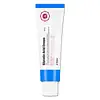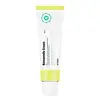What's inside
What's inside
 Key Ingredients
Key Ingredients

 Benefits
Benefits

 Concerns
Concerns

 Ingredients Side-by-side
Ingredients Side-by-side

Betula Alba Juice
AstringentWater
Skin ConditioningPropanediol
SolventTromethamine
BufferingGlycolic Acid
BufferingCetearyl Alcohol
EmollientGlycereth-26
Humectant1,2-Hexanediol
Skin ConditioningNiacinamide
SmoothingButylene Glycol
HumectantGlycerin
HumectantCyclopentasiloxane
EmollientBeeswax
Emulsion StabilisingDimethicone
EmollientPolysorbate 60
EmulsifyingCyclohexasiloxane
EmollientSorbitan Stearate
EmulsifyingPEG-240/Hdi Copolymer Bis-Decyltetradeceth-20 Ether
StabilisingGlyceryl Stearate
EmollientPanthenol
Skin ConditioningSalicylic Acid
MaskingArtemisia Princeps Leaf Extract
Skin ConditioningXanthan Gum
EmulsifyingHydroxyacetophenone
AntioxidantSodium Acrylate/Sodium Acryloyldimethyl Taurate Copolymer
Emulsion StabilisingPEG-100 Stearate
Isohexadecane
EmollientPEG-2m
Emulsion StabilisingHydrogenated Lecithin
EmulsifyingAllantoin
Skin ConditioningSucrose Distearate
EmollientPolysorbate 80
EmulsifyingAdenosine
Skin ConditioningSorbitan Oleate
EmulsifyingDisodium EDTA
Pantolactone
HumectantLactobacillus/Pumpkin Ferment Extract
Skin ConditioningPhenoxyethanol
PreservativeAnanas Sativus Fruit Extract
Skin ConditioningAlchemilla Vulgaris Extract
AstringentArnica Montana Flower Extract
MaskingActinidia Chinensis Fruit Extract
EmollientPyrus Malus Fruit Extract
Skin ConditioningGaultheria Procumbens Leaf Extract
PerfumingBetula Alba Juice, Water, Propanediol, Tromethamine, Glycolic Acid, Cetearyl Alcohol, Glycereth-26, 1,2-Hexanediol, Niacinamide, Butylene Glycol, Glycerin, Cyclopentasiloxane, Beeswax, Dimethicone, Polysorbate 60, Cyclohexasiloxane, Sorbitan Stearate, PEG-240/Hdi Copolymer Bis-Decyltetradeceth-20 Ether, Glyceryl Stearate, Panthenol, Salicylic Acid, Artemisia Princeps Leaf Extract, Xanthan Gum, Hydroxyacetophenone, Sodium Acrylate/Sodium Acryloyldimethyl Taurate Copolymer, PEG-100 Stearate, Isohexadecane, PEG-2m, Hydrogenated Lecithin, Allantoin, Sucrose Distearate, Polysorbate 80, Adenosine, Sorbitan Oleate, Disodium EDTA, Pantolactone, Lactobacillus/Pumpkin Ferment Extract, Phenoxyethanol, Ananas Sativus Fruit Extract, Alchemilla Vulgaris Extract, Arnica Montana Flower Extract, Actinidia Chinensis Fruit Extract, Pyrus Malus Fruit Extract, Gaultheria Procumbens Leaf Extract
Hamamelis Virginiana Water
AstringentButylene Glycol
HumectantCetearyl Alcohol
Emollient1,2-Hexanediol
Skin ConditioningIsotridecyl Isononanoate
EmollientGlyceryl Stearate
EmollientNiacinamide
SmoothingPolymethylsilsesquioxane
Citrus Aurantium Dulcis Oil
MaskingSalvia Sclarea Oil
MaskingArgania Spinosa Kernel Oil
EmollientRhus Semialata Gall Extract
Skin ConditioningSesamum Indicum Seed Oil
EmollientSerenoa Serrulata Fruit Extract
Skin ConditioningCinnamomum Cassia Bark Extract
MaskingPentylene Glycol
Skin ConditioningMethyl Methacrylate Crosspolymer
Ammonium Acryloyldimethyltaurate/Vp Copolymer
Caprylic/Capric Triglyceride
MaskingCaprylyl Methicone
Skin ConditioningHydroxyacetophenone
AntioxidantTromethamine
BufferingAdenosine
Skin ConditioningHexylene Glycol
EmulsifyingCapryloyl Glycine
CleansingBeta-Sitosterol
Emulsion StabilisingSarcosine
Skin ConditioningTocopherol
AntioxidantCarbomer
Emulsion StabilisingDisodium EDTA
Limonene
PerfumingLinalool
PerfumingHamamelis Virginiana Water, Butylene Glycol, Cetearyl Alcohol, 1,2-Hexanediol, Isotridecyl Isononanoate, Glyceryl Stearate, Niacinamide, Polymethylsilsesquioxane, Citrus Aurantium Dulcis Oil, Salvia Sclarea Oil, Argania Spinosa Kernel Oil, Rhus Semialata Gall Extract, Sesamum Indicum Seed Oil, Serenoa Serrulata Fruit Extract, Cinnamomum Cassia Bark Extract, Pentylene Glycol, Methyl Methacrylate Crosspolymer, Ammonium Acryloyldimethyltaurate/Vp Copolymer, Caprylic/Capric Triglyceride, Caprylyl Methicone, Hydroxyacetophenone, Tromethamine, Adenosine, Hexylene Glycol, Capryloyl Glycine, Beta-Sitosterol, Sarcosine, Tocopherol, Carbomer, Disodium EDTA, Limonene, Linalool
Ingredients Explained
These ingredients are found in both products.
Ingredients higher up in an ingredient list are typically present in a larger amount.
1,2-Hexanediol is a synthetic liquid and another multi-functional powerhouse.
It is a:
- Humectant, drawing moisture into the skin
- Emollient, helping to soften skin
- Solvent, dispersing and stabilizing formulas
- Preservative booster, enhancing the antimicrobial activity of other preservatives
Adenosine is in every living organism. It is one of four components in nucleic acids that helps store our DNA.
Adenosine has many benefits when used. These benefits include hydrating the skin, smoothing skin, and reducing wrinkles. Once applied, adenosine increases collagen production. It also helps with improving firmness and tissue repair.
Studies have found adenosine may also help with wound healing.
In skincare products, Adenosine is usually derived from yeast.
Learn more about AdenosineButylene Glycol (or BG) is used within cosmetic products for a few different reasons:
Overall, Butylene Glycol is a safe and well-rounded ingredient that works well with other ingredients.
Though this ingredient works well with most skin types, some people with sensitive skin may experience a reaction such as allergic rashes, closed comedones, or itchiness.
Learn more about Butylene GlycolCetearyl alcohol is a mixture of two fatty alcohols: cetyl alcohol and stearyl alcohol. It is mainly used as an emulsifier. Emulsifiers help prevent the separation of oils and products. Due to its composition, it can also be used to thicken a product or help create foam.
Cetearyl alcohol is an emollient. Emollients help soothe and hydrate the skin by trapping moisture.
Studies show Cetearyl alcohol is non-toxic and non-irritating. The FDA allows products labeled "alcohol-free" to have fatty alcohols.
This ingredient is usually derived from plant oils such as palm, vegetable, or coconut oils. There is debate on whether this ingredient will cause acne.
Due to the fatty acid base, this ingredient may not be Malassezia folliculitis safe.
Learn more about Cetearyl AlcoholDisodium EDTA plays a role in making products more stable by aiding other preservatives.
It is a chelating agent, meaning it neutralizes metal ions that may be found in a product.
Disodium EDTA is a salt of edetic acid and is found to be safe in cosmetic ingredients.
Learn more about Disodium EDTAGlyceryl Stearate is a mix of glycerin and stearic acid.
It is used to stabilize the mixing of water and oil ingredients. By preventing these ingredients from separating, it can help elongate shelf life. It can also help thicken the product's texture.
As an emollient, it helps soften skin and supports barrier-replenishing ingredients.
In cosmetics, Glyceryl Stearate is often made from vegetable oils or synthetically produced.
This ingredient may not be fungal-acne safe
Fun fact: The human body also creates Glyceryl Stearate naturally.
Learn more about Glyceryl StearateHydroxyacetophenone is antioxidant with skin conditioning and soothing properties. It also boosts the efficiency of preservatives.
This ingredient is not irritating or sensitizing.
Niacinamide is a multitasking form of vitamin B3 that strengthens the skin barrier, reduces pores and dark spots, regulates oil, and improves signs of aging.
And the best part? It's gentle and well-tolerated by most skin types, including sensitive and reactive skin.
You might have heard of "niacin flush", or the reddening of skin that causes itchiness. Niacinamide has not been found to cause this.
In very rare cases, some individuals may not be able to tolerate niacinamide at all or experience an allergic reaction to it.
If you are experiencing flaking, irritation, and dryness with this ingredient, be sure to double check all your products as this ingredient can be found in all categories of skincare.
When incorporating niacinamide into your routine, look out for concentration amounts. Typically, 5% niacinamide provides benefits such as fading dark spots. However, if you have sensitive skin, it is better to begin with a smaller concentration.
When you apply niacinamide to your skin, your body converts it into nicotinamide adenine dinucleotide (NAD). NAD is an essential coenzyme that is already found in your cells as "fuel" and powers countless biological processes.
In your skin, NAD helps repair cell damage, produce new healthy cells, support collagen production, strengthen the skin barrier, and fight environmental stressors (like UV and pollution).
Our natural NAD levels start to decline with age, leading to slower skin repair, visible aging, and a weaker skin barrier. By providing your skin niacinamide, you're recharging your skin's NAD levels. This leads to stronger, healthier, and younger looking skin.
Another name for vitamin B3 is nicotinamide. This vitamin is water-soluble and our bodies don't store it. We obtain Vitamin B3 from either food or skincare. Meat, fish, wheat, yeast, and leafy greens contain vitamin B3.
The type of niacinamide used in skincare is synthetically created.
Learn more about NiacinamideTromethamine helps balance the pH and improve the texture of a product. It is synthetically created.
As an emulsifier, Tromethamine prevents oil and water ingredients from separating. This helps stabilize the product and elongate a product's shelf life. Tromethamine also makes a product thicker.
Tromethamine helps balance the pH level of a product. Normal pH level of skin is slightly acidic (~4.75-5.5). The acidity of our skin is maintained by our glands and skin biome. Being slightly acidic allows our skin to create an "acid mantle". This acid mantle is a thin barrier that protects our skin from bacteria and contaminants.
Oral Tromethanmine is an anti-inflammatory drug but plays the role of masking, adding fragrance, and/or balancing pH in skincare.
1,3-Propanediol, 2-amino-2-(hydroxymethyl)-
Learn more about Tromethamine